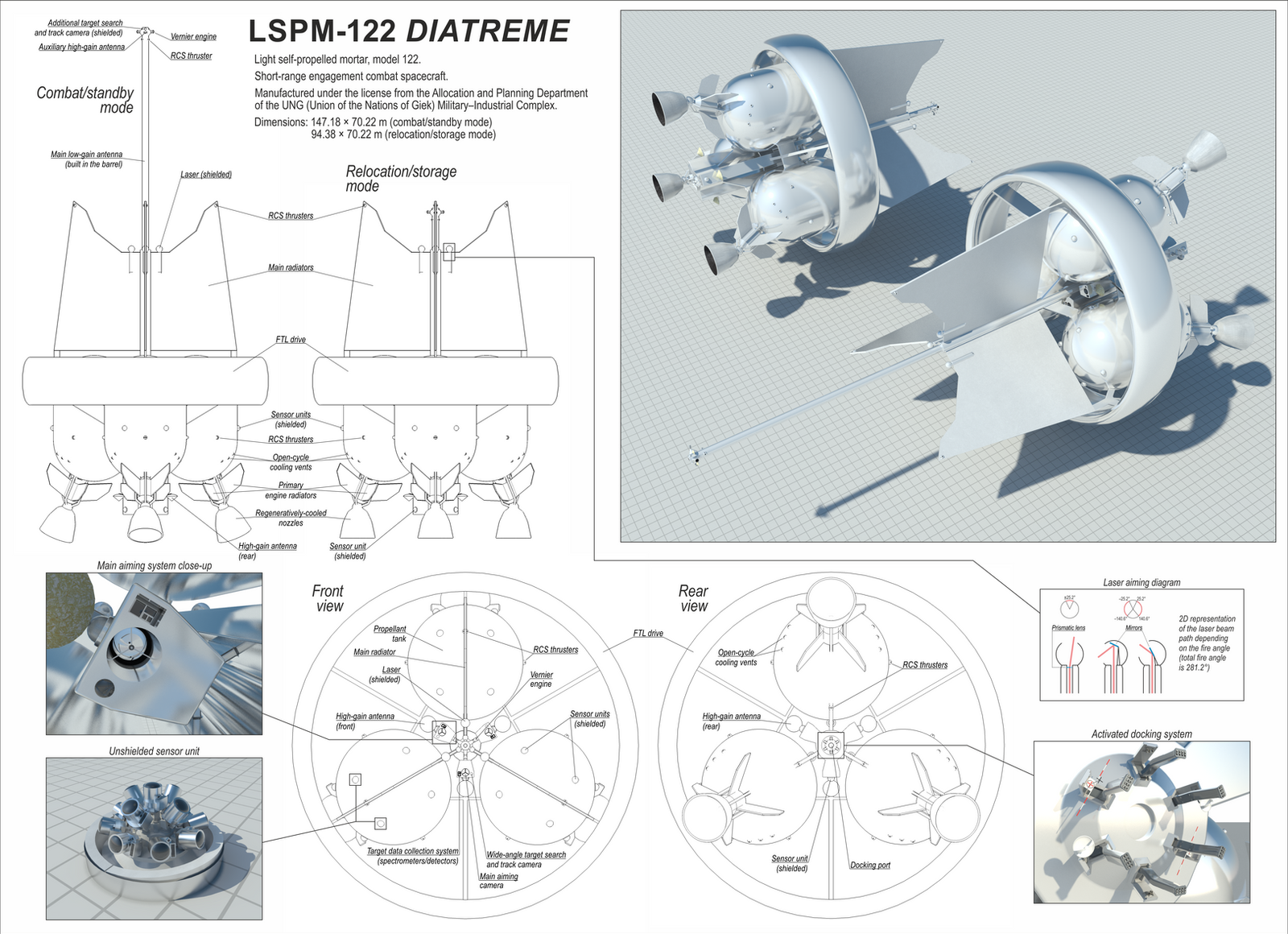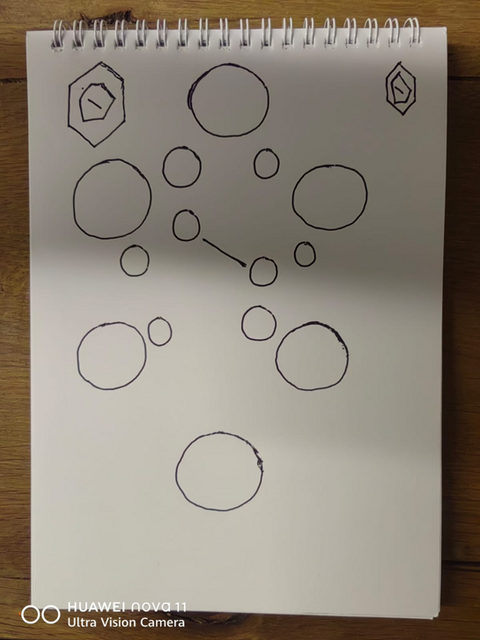HOME | DD
 ChatlaninKyr — LSPM
ChatlaninKyr — LSPM

Published: 2016-09-27 18:50:04 +0000 UTC; Views: 2045; Favourites: 27; Downloads: 10
Redirect to original
Description
DESCRIPTION
LSPM-122 Diatreme is a Giekian light combat spacecraft (CSC) for close-range engagement. Currently it is the most widely produced CSC in history.
The Diatreme’s spacecraft type is known under different names in different militaries: gunship, gunboat, fighter, interceptor, grenadier, tactical military engagement element and, of course, light self-propelled mortar (Giekian classification is the most common, and in many ways the most reasonable). Its defining features are: electromagnetic mass accelerator as the main weapon and high maneuverability as the main countermeasure against enemy attacks. As a rule, LSPMs fire thermonuclear rounds and thus pose a serious danger to any opponent, including large warships. A common drawback of this type of CSC is relatively weak armor, decreased in order to reduce mass.
The LSPM-122 model entered service more than 40 years ago and quickly gained popularity due to its reliability, versatility and the relative cheapness and simplicity of manufacturing and maintenance. In combat, Diatremes can remain operational even after receiving critical damage to the two-thirds of all systems. Their coilgun is suited to launch any type of ammunition, including guided missiles, reconnaissance satellites and atmospheric drones. The adaptable interior of the tanks allows this CSC to be optimized for a long-time standby alert, a quick raid or a large-scale battle. Cheap and readily available substances are used as propellant; maintenance of the LSPM-122 doesn’t require expensive infrastructure, so they are often purchased by countries and organizations that can’t spend large sums on space warfare.
Currently, Diatremes are in service with about a third of the political formations of the galaxy. LSPM-122 of the Giekian military are gradually being replaced by new models, but are still actively produced for export. Despite some general design obsolescence, Diatremes can still effectively counter modern CSCs, provided that they have advantage in numbers (which is easy to achieve given their low cost) and competent tactical support.
Drawbacks of the LSPM-122 are actually the result of the same technical solutions that ensured its popularity. It’s easy to guess that the most vulnerable parts are the massive radiation panels. Although they’re more reliable than liquid droplet radiators, their effectiveness and protection level is lower, so in battle Diatremes have to rely on open-cycle radiators. Gas-core nuclear engines are cheap to produce and can use many types of propellant, but their low (by military standards) specific impulse leads to high mass ratio. Because of this, Diatremes often either dispose large amount of propellant before they engage in combat, or initially have less than half of the load: the result is increased maneuvering capability, but significantly decreased delta-V. In addition, highly radioactive exhaust requires extreme caution during battles near inhabited celestial bodies or space stations, and deployment of the LSPM-122 below 5000 km over a habitable planet is guaranteed to enrage all local environmentalists (though this is a common problem for many other CSC).
Other facts:
· Diatreme, as well as the overwhelming majority of light CSC, is unmanned; it receives commands through instant point-to-point WFCD (wave function collapse detection) communicators.
· Control computers and WFCD communicators are located at the centers of each propellant tank to provide maximum protection. One computer can effectively operate LSPM in case of the others’ failure.
· Giekian CSC classification is based on the spacecraft’s size, mobility and main weapon type. Mobility is divided into self-propelled, limited (without long-range FTL), orbital (without any FTL) and stationary (with only RCS for orientation). Mortar refers to electromagnetic mass accelerator (coilgun or railgun), howitzer — to neutral particle beam, and gun — to laser.
· The reason for the mirror-like appearance is anti-laser cover, which is the distinctive feature of a military spacecraft.
SPECIFICATIONS
(standard configuration)
Dry mass: 2 425 108 kg (including 160 260 kg of coolant)
Propellant mass: 3 400 217 kg, including:
metastable He IV-A — 6 157 kg;
LOx — 1 052 310 kg;
LH2 — 2 341 750 kg.
Wet mass: 5 824 325 kg
Mass ratio: 2.40
Max Δv: 65 282 m/s
Propulsion system
Main propulsion system
×3 Open-cycle gas-core nuclear thermal rocket
Fuel: Uranium Hexafluoride
Propellant: LH2 / LOx
High gear (LH2):
Thrust: 45 860 048 N per engine, 137 580 144 N total
Specific impulse: 8 472 s
Mass flow: 1 655.4 kg/s
Burn time: 1415 s (23 min 35 s)
Maximum wet mass acceleration: 23.62 m/s2 (2.41 g)
Maximum theoretical acceleration: 56.75 m/s2 (5.78 g)
Low gear (LOx):
Thrust: 95 931 691 N per engine, 287 795 073 N total
Specific impulse: 4 795 s
Mass flow: 6118.1 kg/s
Burn time: 172 s (2 min 52 s)
Maximum wet mass acceleration: 49.41 m/s2 (5.04 g)
Maximum theoretical acceleration: 118.72 m/s2 (12.10 g)
Vernier engines
Fuel/propellant: metastable He IV-A
Thrust: 154 028 N
Specific impulse: 2 123 s
RCS
Fuel/propellant: metastable He IV-A
Thrust: 838 N
Specific impulse: 1 940 s
Armament (specifications to be determined)
Electromagnetic mass accelerator (coilgun)
×3 X-ray laser
SketchUp + Vray.
Note: this model looks dull and uninteresting and lacks details partly because military spacecraft in the setting are supposed to be like that; and only partly — because it’s really dull and uninteresting and lacks details.
Русскоязычная версия
Related content
Comments: 9

Pretty cool~ Shall read more when I get the chance
👍: 0 ⏩: 1

Thanks
Just ask if something is unclear
👍: 0 ⏩: 1

Nope, its all pretty clear I think~
Welcomeness
👍: 0 ⏩: 0

Thank you
Well, I don't think I can really speak about any distinctive style so far, but yes, this is supposed to be a typical example highlighting some of the setting's rules that I may have already mentioned.
👍: 0 ⏩: 1

You are very welcome. Well, if its not the style, it fits the pattern of technological design.
👍: 0 ⏩: 0

I admire you all the more for including the mathematical specifications. I'm hopeless at that sort of thing. XD
I really hope we get to see more of the Initial Stage spacecraft.
👍: 0 ⏩: 1

Thank you very much
It actually took me three days of finding data, calculating, cursing at the results, adjusting model and initial data and calculating again. Many values were assumed or roughly estimated. And in the end I was completely out of any calculating enthusiasm, so I haven't even started to approach weapon or armor specifications
I do hope to make more of them, beginning with other types, i.e. particle beam and laser CSCs, but knowing my laziness it'll probably take a long time before they'd be finished.
👍: 0 ⏩: 1

Holy crap! I wouldn't have the patience for three whole days of that... XD
That's a good idea, to progress slowly starting with different variants. Baby steps.
👍: 0 ⏩: 0



























